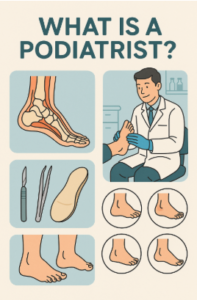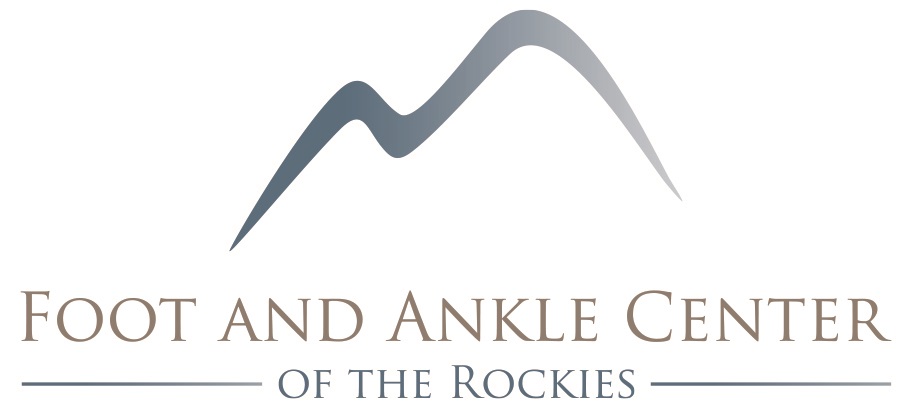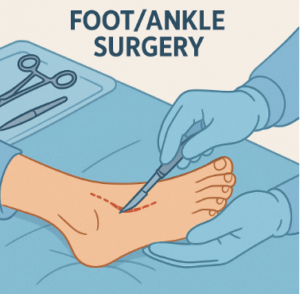
Take Action to Treat Ankle Arthritis!
April 15, 2025
Common Skiing and Snowboarding Injuries
June 20, 2025What is a Podiatrist/Foot and Ankle Surgeon?

A podiatrist is a medical professional who specializes in diagnosing, treating, and preventing conditions related to the feet, ankles, and lower extremities. Podiatrists are sometimes referred to as “foot doctors,” but their expertise extends beyond just the feet. They are trained to treat a wide range of issues affecting the lower limbs, from minor problems like ingrown toenails to more complex conditions such as fractures, infections, or even surgeries. In the following blog, Foot & Ankle Center of the Rockies will explore the profession in detail.
Training and Education of a Podiatrist
Becoming a podiatrist requires years of education and training.
- After completing a 4 year undergraduate degree (usually in a science-related field), aspiring podiatrists must attend a podiatric medical school for four years to earn a Doctor of Podiatric Medicine (DPM) degree.
- During this time, students receive in-depth training in anatomy, pharmacology, surgery, biomechanics, and other medical sciences.
- After earning their DPM, podiatrists complete a surgical residency program, which typically lasts 3 years.
This hands-on training allows them to gain experience in treating various foot and ankle conditions under the supervision of seasoned podiatrists and other medical professionals. Some podiatrists even elect to complete additional training for 1 year in a fellowship program following residency!
What Does a Podiatrist Treat?
Podiatrists are experts in understanding the mechanics and function of the feet and ankles, as well as how these parts of the body interact with the rest of the musculoskeletal system. This allows them to assist with a wide variety of conditions and problems, such as…
- Foot Pain: Heel pain, arch pain, and ball-of-foot pain (like plantar fasciitis and metatarsalgia).
-
- Toe Problems: Bunions, hammertoes, and ingrown toenails.
- Skin and Nail Conditions: Fungal infections, warts, calluses, corns, and athlete’s foot.
- Sports Injuries: Sprains, fractures, tendon injuries, and stress fractures.
- Arthritis: Joint pain, swelling, and stiffness in the feet and ankles.
- Diabetic Foot Complications: Ulcers, infections, and circulation problems.
- Structural Problems: Flat feet, high arches, and gait issues.
- Nerve Issues: Neuromas (pinched nerves) and tarsal tunnel syndrome.
Podiatrists offer both non-surgical treatments — like orthotics, medications, and physical therapy — and surgical options when necessary. Their goal is to help patients stay active, comfortable, and healthy on their feet.
What Type of Surgeries Do They Perform?
Common surgeries that podiatrists perform include:
- Bunion Surgery (Bunionectomy)
Bunions are painful, bony bumps that develop on the joint at the base of the big toe.
When conservative treatments like orthotics or padding don’t work, podiatrists perform a bunionectomy. This involves realigning the bones, ligaments, and tendons to restore normal foot function.
- Hammertoe Surgery
Hammertoes occur when one or more toes are permanently bent downward.
Surgery may involve releasing tight tendons, removing bone, or fusing joints to straighten the toe and relieve pain.
- Plantar Fascia Release
Chronic heel pain caused by plantar fasciitis can sometimes require surgery.
In a plantar fascia release, a podiatrist cuts part of the ligament to relieve tension and inflammation.
- Achilles Tendon Repair
The Achilles tendon is the strongest tendon in the body, but injuries like tears or ruptures can occur, especially in athletes.
Podiatric surgeons perform Achilles tendon repairs to stitch the torn ends of the tendon back together.
- Fracture Repair and Trauma Surgery
Broken bones in the foot or ankle often require more than just a cast.
Podiatrists can realign and stabilize fractures using pins, plates, or screws to promote proper healing and restore strength.
- Flatfoot Reconstruction
Flat feet can cause pain and instability.
For severe cases, a podiatrist may perform flatfoot reconstruction, which could include tendon repairs, bone realignment, and fusions.
- Neuroma Removal
Morton’s neuroma, a painful thickening of nerve tissue between the toes, may require surgical removal if non-surgical treatments fail.
The goal is to alleviate nerve compression and restore comfort.
- Ingrown Toenail Surgery
While it might seem minor, chronic ingrown toenails that become infected often need surgical intervention.
Podiatrists may remove part or all of the toenail and even destroy the nail matrix to prevent regrowth.
- Diabetic Foot Surgery
Patients with diabetes are at high risk for foot complications.
Podiatric surgeons perform specialized procedures to remove infected tissue, correct deformities, or even amputate when necessary to save the patient’s life.
- Ankle Arthroscopy
Using a small camera inserted into the ankle joint, podiatrists can diagnose and treat issues like cartilage injuries, loose bone fragments, or arthritis with minimal invasion, promoting faster recovery.
Final Thoughts
Your feet carry you through life, and it’s easy to take them for granted—until something hurts. A podiatrist can help diagnose the problem, relieve your pain, and restore mobility. So next time your feet are trying to tell you something, don’t ignore them—listen, and consider booking an appointment with a foot and ankle expert.
At Foot & Ankle Center of the Rockies, we offer a full range of podiatric services to patients with an emphasis on treatment specifically designed for you as an individual. Our practice is ready to serve your entire family with excellent care for the unique podiatric concerns of children, adults, and seniors. Whether you need a routine podiatric checkup, surgical or non-surgical treatment for a foot or ankle disorder, or custom orthotics to increase comfort and sports performance, Foot & Ankle Center of the Rockies is the right choice!


